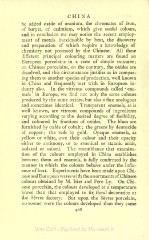Page 498 - Oriental Series Japan and China, Brinkly
P. 498
CHINA
be added oxide of uranium, the chromates of iron,
of baryta, of cadmium, which give useful colours,
and in conclusion we may notice the recent employ-
ment of metals inoxidisable by heat, the discovery
and preparation of which require a knowledge of
chemistry not possessed by the Chinese. All these
different principal colouring matters are found on
European porcelains in a state of simple mixture
;
on Chinese porcelains, on the contrary, the oxides are
dissolved, and this circumstance justifies us in compar-
ing them to another species of production, well known
in China and frequently met with in European in-
dustry also. In the vitreous compounds called ' ena-
mels ' in Europe, we find not only the same colours
produced by the same oxides, but also a flux analogous
and sometimes identical. Transparent enamels, as is
well known, are vitreous compounds of ingredients
varying according to the desired degree of fusibility,
and coloured by fractions of oxides. The blues are
furnished by oxide of cobalt the greens by deutoxide
;
of copper ; the reds by gold. Opaque enamels, as
yellow or white, owe their colour and their opacity
either to antimony, or to arsenical or stannic acids,
isolated or mixed. The resemblance that examina-
tion of the colours employed in China establishes
between them and enamels, is fully confirmed by the
manner in which the colours behave under the influ-
ence of heat. Experiments have been made upon Chi-
nese and European wares with the assortments of Chinese
colours obtained by M. Itier and Pere Ly. On Chi-
nese porcelain, the colours developed at a temperature
lower than that employed to fix floral decoration at
the Sevres factory. But upon the Sevres porcelain,
no sooner were the colours developed than they came
408

